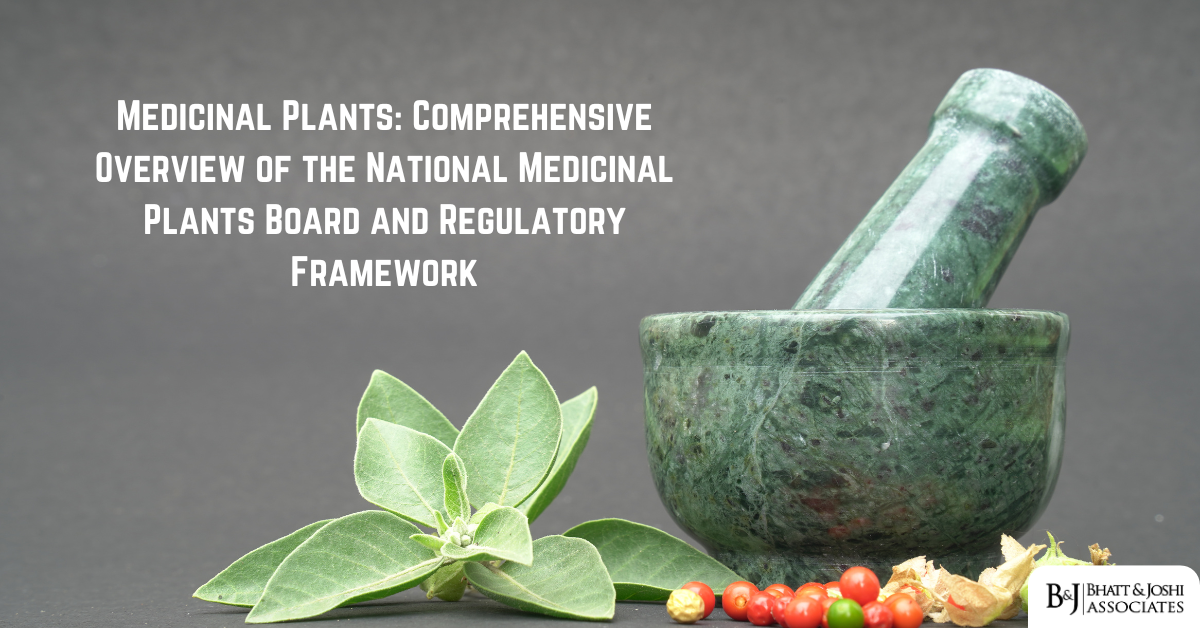Introduction
Medicinal plants hold a profound significance in the healthcare systems of India, blending ancient traditions with contemporary pharmaceutical innovations. Their prominence in Ayurveda, Siddha, Unani, and modern medicine underscores their value as both cultural artifacts and economic assets. However, the rising global demand for herbal remedies and pharmaceutical derivatives has presented both opportunities and challenges. These include issues of overharvesting, habitat degradation, and unsustainable trade practices, which necessitate a well-structured regulatory framework and active governance. The National Medicinal Plants Board (NMPB) serves as the cornerstone of this regulatory framework in India, promoting the sustainable cultivation, conservation, and utilization of medicinal plants.
This article explores the multifaceted role of medicinal plants in India, the establishment and functioning of the NMPB, the regulatory mechanisms governing the sector, significant judicial interventions, and the challenges and opportunities shaping the future of medicinal plants.
Historical and Cultural Relevance of Medicinal Plants in India
India has a rich heritage of traditional medicine, with ancient texts like the Charaka Samhita and Sushruta Samhita documenting the use of medicinal plants for therapeutic purposes. These plants formed the bedrock of traditional healthcare systems, providing remedies for ailments ranging from common colds to chronic diseases. The use of these plants transcends mere medicinal purposes, integrating into the spiritual and cultural practices of Indian society.
The global recognition of traditional Indian medicine, fueled by increasing interest in Ayurveda and herbal therapies, has further elevated the status of medicinal plants. However, this recognition has brought challenges, including the overexploitation of natural resources, loss of biodiversity, and questions surrounding the intellectual property rights of traditional knowledge holders.
Establishment and Objectives of the National Medicinal Plants Board
Recognizing the critical need to conserve medicinal plants and ensure their sustainable utilization, the Government of India established the National Medicinal Plants Board (NMPB) in 2000 under the Ministry of AYUSH. The NMPB serves as a nodal agency for coordinating all matters related to medicinal plants, focusing on conservation, cultivation, trade promotion, and integration into healthcare systems.
Objectives of the NMPB
- Conservation of Medicinal Plants: To ensure that medicinal plants, especially endangered and rare species, are preserved through in-situ and ex-situ conservation methods.
- Promotion of Cultivation: To reduce dependency on wild resources by encouraging large-scale cultivation of medicinal plants.
- Market and Trade Development: To streamline the supply chain and facilitate market access for cultivators and traders.
- Research and Development: To support scientific studies that validate the efficacy and safety of medicinal plants, integrating traditional knowledge with modern science.
- Awareness and Capacity Building: To educate stakeholders, including farmers, researchers, and healthcare providers, about the sustainable use of medicinal plants.
The NMPB implements its objectives through various schemes, such as the Central Sector Scheme on Conservation, Development, and Sustainable Management of Medicinal Plants and initiatives under the National AYUSH Mission.
Regulatory Framework Governing Medicinal Plants in India
The regulation of medicinal plants in India is a complex interplay of conservation laws, trade policies, and quality standards. Several key legislations form the backbone of this framework:
Biological Diversity Act, 2002
This act is a cornerstone of India’s biodiversity conservation efforts. It provides a framework for sustainable use and equitable benefit-sharing of biological resources, including medicinal plants. The act established the National Biodiversity Authority (NBA) to regulate access to genetic resources and prevent bio-piracy.
The NBA collaborates with the NMPB to ensure that the extraction and trade of medicinal plants do not harm biodiversity or exploit traditional knowledge holders. For instance, permissions are required for accessing bio-resources for commercial purposes, and benefit-sharing agreements must be negotiated with local communities.
Forest Conservation Act, 1980
Many medicinal plants grow in forest ecosystems, making the Forest Conservation Act crucial in regulating their harvest. The act prohibits the indiscriminate extraction of forest resources, mandating approval for non-forest activities in forest areas.
State forest departments often work with the NMPB to implement conservation projects and monitor the sustainable collection of medicinal plants from forests. This coordination ensures that biodiversity is not sacrificed for economic gains.
Drugs and Cosmetics Act, 1940
The Drugs and Cosmetics Act governs the manufacture, sale, and distribution of herbal drugs. It ensures that medicinal plants used in Ayurveda, Siddha, and Unani medicines meet prescribed quality standards. The NMPB collaborates with regulatory bodies to promote good manufacturing practices (GMP) and ensure the safety and efficacy of herbal formulations.
Wildlife Protection Act, 1972
Certain medicinal plants, such as sandalwood, are classified as protected species under the Wildlife Protection Act. The act imposes restrictions on their harvest and trade, with penalties for violations. This ensures that rare and endangered species are not overexploited.
Conservation and Cultivation Initiatives by the NMPB
In-Situ Conservation
In-situ conservation involves preserving medicinal plants in their natural habitats. The NMPB supports projects that establish Medicinal Plant Conservation Areas (MPCAs) in biodiversity-rich regions. These areas are protected from activities like deforestation and overharvesting, ensuring that native species thrive.
Ex-Situ Cultivation
To reduce pressure on wild resources, the NMPB promotes the cultivation of medicinal plants outside their natural habitats. Financial incentives and technical support are provided to farmers under schemes like the National AYUSH Mission. This approach not only conserves biodiversity but also provides economic opportunities for rural communities.
Community Participation
The NMPB emphasizes community involvement in conservation efforts. Local communities are encouraged to participate in the sustainable harvest of medicinal plants and share in the benefits derived from their use. This participatory approach aligns with the principles of the Biological Diversity Act.
Research and Development in Medicinal Plants
Research is a critical component of the NMPB’s mandate. The board funds studies to validate the therapeutic properties of medicinal plants, develop new formulations, and address challenges in cultivation and conservation. Collaborative research with institutions like the Indian Council of Agricultural Research (ICAR) and the Council of Scientific and Industrial Research (CSIR) enhances scientific understanding and promotes innovation.
For example, studies on plants like Ashwagandha (Withania somnifera) and Giloy (Tinospora cordifolia) have provided scientific validation for their traditional uses, boosting their acceptance in global markets.
Challenges in the Regulation of Medicinal Plants in India
Despite significant progress, several challenges hinder the effective regulation and sustainable use of medicinal plants:
Overexploitation and Habitat Loss
The high demand for medicinal plants often leads to overharvesting, threatening the survival of species. Habitat destruction due to deforestation and urbanization exacerbates the problem, reducing the availability of wild resources.
Illegal Trade
The illegal trade of medicinal plants, driven by high market demand and weak enforcement, poses a significant challenge. Rare species are often smuggled out of the country, bypassing regulatory controls and depriving local communities of benefits.
Climate Change
Climate change affects the growth and distribution of medicinal plants, altering their chemical composition and efficacy. Adaptive measures are needed to mitigate these impacts and ensure the sustainability of medicinal plant resources.
Lack of Market Access
Farmers and small-scale cultivators often face difficulties in accessing markets due to inadequate infrastructure and knowledge about market dynamics. Strengthening market linkages and providing fair prices are essential for promoting the cultivation of medicinal plants.
Intellectual Property Issues
The commercialization of traditional knowledge raises concerns about bio-piracy and the equitable sharing of benefits. Strengthening intellectual property protections and benefit-sharing mechanisms is crucial to addressing these issues.
Judicial Interventions in Medicinal Plant Conservation
Indian courts have played a pivotal role in addressing issues related to medicinal plant conservation and sustainable use. Landmark judgments have underscored the importance of balancing economic interests with ecological sustainability.
In T.N. Godavarman Thirumulpad v. Union of India (1996), the Supreme Court highlighted the need for strict implementation of forest conservation laws, directly impacting the regulation of medicinal plants. The judgment led to the establishment of the Forest Advisory Committee, which evaluates proposals for non-forest activities.
In Centre for Environmental Law v. Union of India (2013), the Supreme Court directed authorities to implement conservation strategies for endangered medicinal plants. The judgment emphasized the responsibility of the state to protect biodiversity under the Biological Diversity Act.
International Frameworks and India’s Commitment
India’s regulatory efforts align with international agreements such as the Convention on Biological Diversity (CBD) and the Nagoya Protocol. These frameworks promote sustainable use, conservation, and equitable benefit-sharing of biological resources.
The Convention on International Trade in Endangered Species of Wild Fauna and Flora (CITES) regulates the international trade of medicinal plants. The NMPB works closely with the Ministry of Environment, Forest, and Climate Change to ensure compliance with CITES provisions.
Opportunities and the Future of Medicinal Plants
The increasing global demand for herbal products presents significant opportunities for India to become a leader in the medicinal plant industry. To realize this potential, the NMPB must address existing challenges and leverage technological innovations.
Digital tools such as GIS mapping and blockchain can enhance traceability and transparency in the supply chain. Collaborations with global organizations can boost research and market access, ensuring that India’s medicinal plants are recognized for their quality and efficacy.
Conclusion: Securing the Future of Medicinal Plants in India
Medicinal plants are an invaluable resource for healthcare, livelihoods, and cultural heritage. The National Medicinal Plants Board, through its proactive initiatives and regulatory oversight, has made substantial progress in promoting their sustainable use and conservation. However, addressing challenges like habitat loss, illegal trade, and market barriers requires concerted efforts from all stakeholders.
By integrating traditional knowledge with modern science and aligning national policies with international frameworks, India can secure its position as a global leader in
the medicinal plant sector. The NMPB’s role will remain pivotal in ensuring that the benefits of medicinal plants are realized equitably and sustainably, contributing to the health and economic well-being of future generations.














